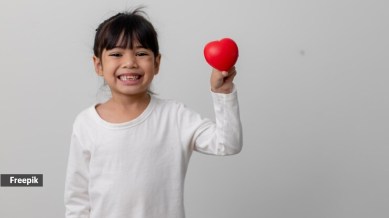Five foods to help increase haemoglobin levels in children
Some underlying medical conditions like chronic kidney disease, inflammatory bowel disease, or certain infections, can interfere with haemoglobin production or red blood cell survival.

As parents, we’re always looking for ways to keep our children healthy and strong. One important aspect of their health that sometimes gets overlooked is their haemoglobin level.
Haemoglobin is a protein in red blood cells that carries oxygen throughout the body, and low levels can lead to fatigue, weakness, and other health issues.
monthly limit of free stories.
with an Express account.
The good news is that we can help boost our kids’ haemoglobin levels through the foods they eat.
But, let’s first understand what the most common causes of low haemoglobin levels in children are
Sadhna Singh, senior nutritionist at HERENOW Official, says, “Low haemoglobin, a condition called anaemia, can have several culprits in children. Iron is the key building block for haemoglobin, the protein in red blood cells that carries oxygen. If a child’s diet lacks iron-rich foods or their body struggles to absorb iron, it can lead to a dip in haemoglobin levels.”
Another reason can be folate or vitamin B12 deficiency. These nutrients are essential for red blood cell production. A lack of them can hinder the process and result in anaemia.
Some underlying medical conditions, Singh informs, like chronic kidney disease, inflammatory bowel disease, or certain infections, can interfere with haemoglobin production or red blood cell survival.
“Conditions like heavy menstrual bleeding in adolescents or internal bleeding from ulcers or other issues can lead to significant blood and iron loss, contributing to anaemia,” she states.
Five foods that are effective in increasing haemoglobin levels in children
According to Singh, here are five powerhouse foods that can naturally boost haemoglobin levels in children:
Red Meat (Especially Organ Meats): Red meat, particularly organ meats like liver, is a champion source of heme iron. This type of iron is more easily absorbed by the body than the non-heme iron found in plant-based foods.
Green Leafy Vegetables (Spinach, Kale, etc.): While they contain non-heme iron, these vegetables are packed with folate and other nutrients that support healthy red blood cell production. Pairing them with vitamin C-rich foods (like citrus fruits) can enhance iron absorption.
Legumes (Lentils, Beans, Chickpeas): Legumes offer a good source of iron and are rich in protein, which is also important for haemoglobin synthesis.
Fortified Cereals: Many breakfast cereals are fortified with iron, making them a convenient way to boost a child’s intake. Be sure to choose whole-grain options for added fibre and other nutrients.
Dried Fruits (Raisins, Prunes, Apricots): These tasty treats are a concentrated source of iron and other minerals. A handful of dried fruits can be a great snack for kids to help maintain healthy haemoglobin levels.
Foods that should be avoided
Singh says “Yes, certain foods can hinder iron absorption and should be consumed in moderation, especially when paired with iron-rich meals.” These are:
Calcium-Rich Foods: Calcium competes with iron for absorption in the gut. This doesn’t mean children should avoid dairy products altogether, but it’s best to space them out from iron-rich meals or snacks.
Tannins: Found in tea and coffee, tannins can bind to iron and inhibit its absorption. Limiting tea or coffee intake around mealtimes can help maximise iron uptake.
Phytates: These compounds, found in whole grains and legumes, can also interfere with iron absorption. Soaking, sprouting, or fermenting these foods can help reduce phytate levels and improve iron bioavailability.